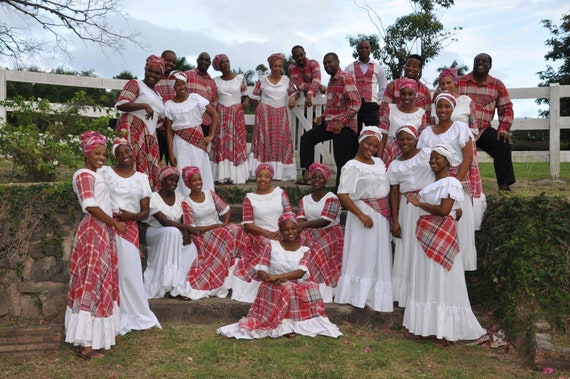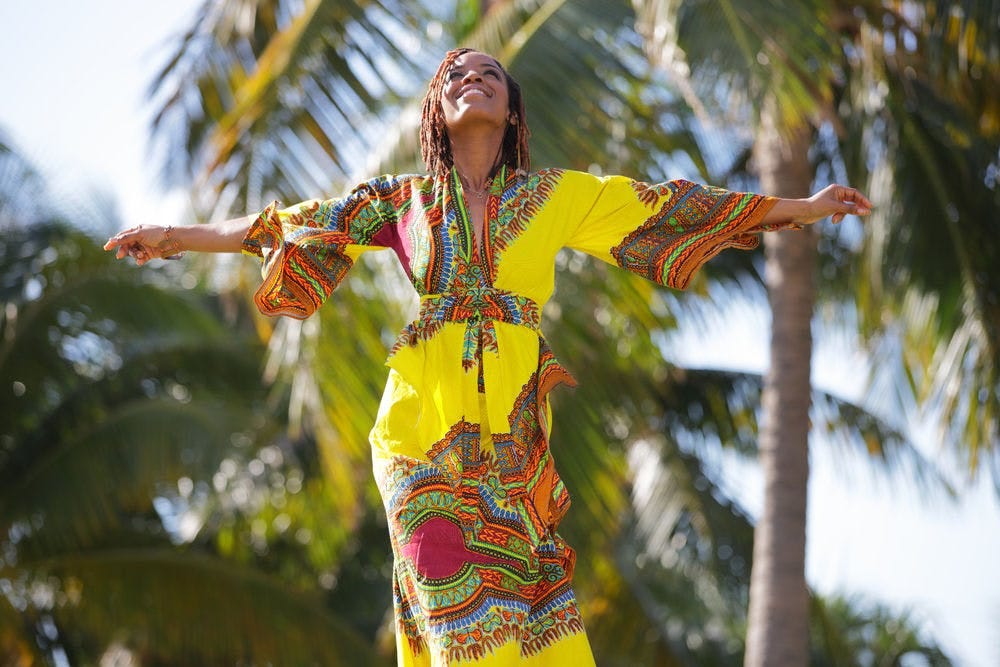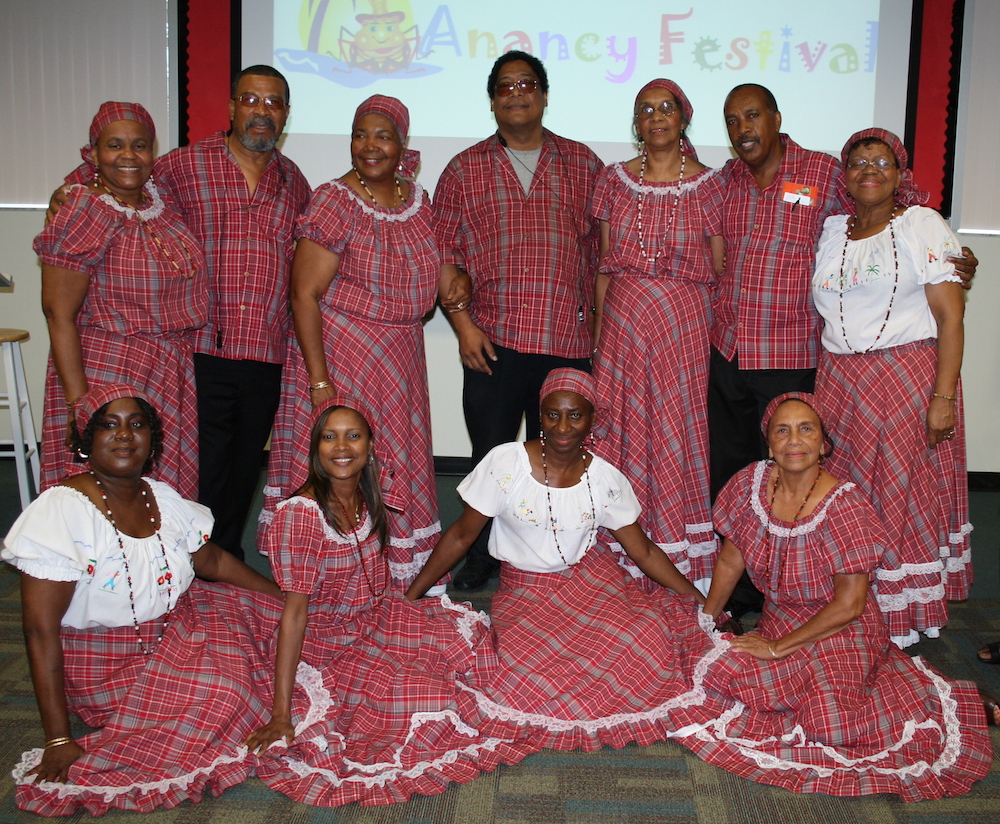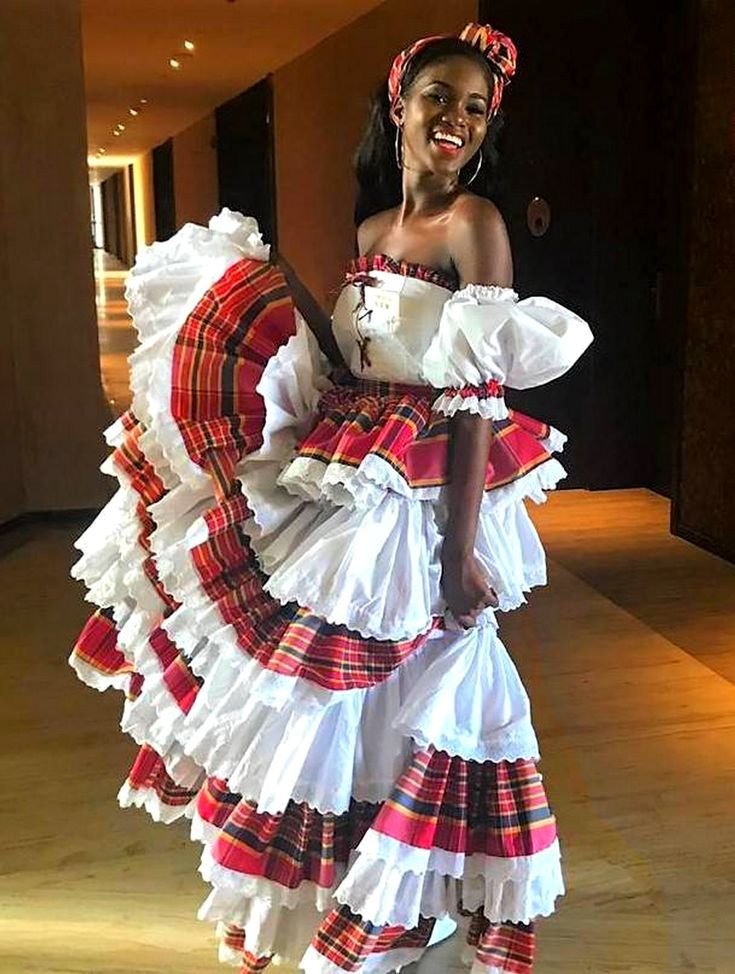Traditional Jamaican clothing includes the bandana skirt, head scarf, ruffled skirt, blouse, and dashiki, featuring a mix of African and European influences and reflecting Jamaica’s history and culture. The bandana, a plaid cotton material in red, yellow, and white, is considered the unofficial national fabric, originally used for head ties and aprons by female Jamaican farmers and vendors.
These outfits are part of Jamaica’s vibrant cultural heritage and are often worn in traditional celebrations and events. The colorful and airy nature of the clothing makes it suitable for the warm climate of the Caribbean, and it continues to be an important aspect of Jamaican identity and pride.

Credit: www.etsy.com
Table of Contents
ToggleThe Essence Of Jamaican Attire
Traditional Jamaican clothing encompasses various styles such as the bandana skirt and headscarf, ruffled skirt and blouse, and the dashiki. These garments feature vibrant colors and patterns influenced by both African and European cultures, reflecting Jamaica’s rich history and heritage.
The bandana fabric, with its distinctive plaid design in red, yellow, and white, holds significant cultural importance and is considered the unofficial national fabric of Jamaica.
Traditional Jamaican clothing is a vibrant reflection of the country’s rich cultural heritage. From the bold colors and patterns to the unique styles, Jamaican attire showcases the fusion of African and European influences. The clothing not only serves as a form of expression but also holds deep symbolism and significance. Let’s explore the essence of Jamaican attire through the lens of symbolism in colors and patterns and the influence of African and European styles.
Symbolism In Colors And Patterns
Colors and patterns play a crucial role in traditional Jamaican clothing, representing various aspects of Jamaican culture and history. Each color holds its own significance:
- Red: Symbolizes the resilience and strength of the Jamaican people.
- Yellow: Represents the country’s abundant sunshine and warm spirit.
- Green: Signifies Jamaica’s lush vegetation and natural beauty.
- Black: Reflects the African roots and the struggles faced by Jamaicans throughout history.
In addition to colors, patterns also hold deep meaning in Jamaican attire. The most iconic pattern is the bandana, characterized by its vibrant checkered design. The bandana pattern represents the resilience and determination of the Jamaican people, as it was historically worn by enslaved Africans as a symbol of resistance and unity.
Influence Of African And European Styles
Jamaican attire is a beautiful blend of African and European styles, reflecting the country’s complex history. The African influence is evident in the use of bold colors, intricate patterns, and loose-fitting garments that allow for comfort and ease of movement.
On the other hand, European styles have also left their mark on Jamaican clothing, particularly through the introduction of tailored garments and ruffled details. The ruffled skirt and blouse, for example, showcases European influences while still maintaining elements of traditional Jamaican aesthetics.
This unique fusion of African and European styles in Jamaican clothing represents the resilience and adaptability of the Jamaican people in embracing and celebrating their diverse heritage.
Bandana Fabric: Jamaica’s Unofficial National Textile
Bandana fabric is a popular textile used in traditional Jamaican clothing. This brightly colored, printed cotton fabric is recognized as Jamaica’s unofficial national textile. The fabric has a rich history in Jamaican culture and is still used in contemporary fashion today.
Historical Significance
Bandana fabric was first brought to Jamaica by African slaves who used it as a headwrap. The fabric’s bright colors and bold patterns were a symbol of resistance and pride in their African heritage. Over time, the fabric became a staple in Jamaican culture and was used in traditional clothing, particularly in the Quadrille dance.
The Quadrille dance was brought to Jamaica by European colonizers and was a popular dance form among the upper class. However, the enslaved population adapted the dance and incorporated their own cultural elements, including the use of bandana fabric in their clothing. Today, the Quadrille dance is still performed in Jamaica, and bandana fabric remains an important part of the costume.
Contemporary Use In Fashion
Bandana fabric has also been embraced in contemporary fashion. It has been used in various ways, from accessories such as headwraps and bags to clothing such as dresses and shirts. The fabric’s bold patterns and bright colors are popular in streetwear fashion, particularly among Jamaican youth.
Additionally, Jamaican designers have incorporated bandana fabric into their collections, showcasing the versatility and beauty of the textile. The fabric has also been used in international fashion shows, bringing attention to Jamaican culture and fashion.
| Item | Price | Retailer |
|---|---|---|
| Jamaican Flag Maxi Dress | $35.00 | ShopEverythingJamaica (Etsy) |
| Jamaican Cultural Bandana Dress | $90.00 | AckeeTreeClothing (Etsy) |
| Jamaican Flag Fitted Dress | $64.90 | Magnificent Crowns |
In conclusion, bandana fabric is an important part of Jamaican culture and history. It has a rich and complex history that has influenced Jamaican fashion both traditionally and in contemporary times. The fabric’s bright colors and bold patterns continue to captivate and inspire designers and fashion enthusiasts worldwide.
Iconic Jamaican Garments
In Jamaica, traditional clothing reflects the country’s rich cultural heritage and historical influences. Iconic Jamaican garments such as the Quadrille Dress and the Ruffled Skirt and Blouse are deeply rooted in the island’s history and are still worn with pride by many Jamaicans today.
The Quadrille Dress
The Quadrille Dress is a symbol of Jamaican culture and tradition. It is a brightly colored, full-skirted dress adorned with intricate embroidery and lace detailing. This traditional garment is often worn during celebratory events and cultural performances, showcasing the vibrant and lively spirit of Jamaica.
The Ruffled Skirt And Blouse
The Ruffled Skirt and Blouse ensemble is a classic Jamaican attire that exudes elegance and charm. The ruffled skirt, often made from lightweight fabrics, is paired with a matching blouse featuring delicate ruffles and intricate patterns. This traditional outfit is a testament to the fusion of African and European influences in Jamaican fashion.
Traditional Male Attire
Traditional Jamaican clothing for men is a vibrant and essential part of the island’s cultural identity. The attire is a fusion of African and European influences and carries deep historical and cultural significance. The traditional male attire in Jamaica includes the iconic dashiki, which is worn for both ceremonial and everyday purposes.
The Dashiki’s Role
The dashiki holds a prominent role in traditional Jamaican male attire. It is a loose-fitting, brightly colored tunic with ornate embroidery or print patterns. Traditionally, the dashiki was worn during ceremonial events and special occasions, symbolizing cultural pride and heritage. Today, it is also embraced as a fashionable and everyday clothing choice, reflecting the enduring legacy of Jamaican traditions.
Ceremonial And Everyday Wear
In Jamaican culture, traditional male attire serves both ceremonial and everyday wear purposes. The dashiki, in particular, transitions seamlessly from formal events to casual settings, showcasing the versatility and significance of this iconic garment. Whether it’s a cultural celebration or a typical day, traditional Jamaican clothing for men remains an integral part of the island’s rich heritage.
Adornments And Accessories
Traditional Jamaican clothing is a vibrant mix of African and European influences. From the bandana skirt and headscarf to the ruffled skirt and blouse, these outfits incorporate elements of Jamaican history and culture. The iconic ‘bandana’ fabric, with its red, yellow, and white plaid pattern, holds a special place as the unofficial national fabric of Jamaica.
Adornments and Accessories play a significant role in Traditional Jamaican Clothing. Head Scarves and Ties, as well as Jewelry and Embellishments, are used to enhance the beauty of the clothing and add a touch of personal style. Head Scarves and Ties are an essential part of Jamaican culture. They are commonly worn as a symbol of African heritage and pride. The Head Scarves are made from a variety of materials such as cotton, silk, or bandana fabric. They come in different colors, patterns, and sizes. Some popular Head Scarves and Ties are the Jamaican flag colors, black, red, and green, and the traditional bandana print. Jewelry and Embellishments are also commonly used to adorn Traditional Jamaican Clothing. The jewelry is made from a variety of materials such as gold, silver, and beads. Some popular jewelry pieces are bracelets, necklaces, and earrings. The Embellishments are added to the clothing to enhance its beauty. They are made from a variety of materials such as sequins, beads, and embroidery. In conclusion, Adornments and Accessories are an essential part of Traditional Jamaican Clothing. Head Scarves and Ties and Jewelry and Embellishments are used to enhance the beauty of the clothing and add a touch of personal style. The use of these items reflects the rich cultural heritage of Jamaica and its people.Maroon Heritage And Clothing
Traditional Jamaican clothing showcases a vibrant mix of African and European influences. From the bandana skirt and headscarf to the ruffled skirt and blouse, these styles incorporate bold colors and patterns that reflect Jamaica’s rich history and culture. Embrace the heritage with authentic Jamaican clothing.
Garments Symbolizing Freedom
Traditional Jamaican clothing is not only a fashion statement but also a symbol of the country’s rich cultural heritage. The Maroons, who were runaway slaves, played a significant role in shaping Jamaican culture and clothing. Their garments were not only practical but also symbolic of their freedom. The Maroons used natural fibers, such as cotton and hemp, to make their clothing. They created garments that were lightweight, comfortable, and allowed freedom of movement. The colors used in their clothing were often earthy and natural, such as brown, beige, and green.Turbans And Loincloths
One of the most distinctive features of Maroon clothing is the turban. The turban was a practical way to keep their hair out of their faces while working in the fields. However, it was also a symbol of their African heritage and a way to show pride in their culture. Another garment commonly worn by the Maroons was the loincloth. The loincloth was a simple piece of fabric worn around the waist and between the legs. It allowed for freedom of movement and was practical for hot climates. Like the turban, the loincloth was also a symbol of the Maroons’ African heritage. In conclusion, traditional Jamaican clothing is not only a fashion statement but also a representation of the country’s history and culture. The Maroons’ clothing is a prime example of how clothing can be practical, comfortable, and symbolic. The use of natural fibers and earthy colors in Maroon clothing reflects their connection to the land and their African heritage.Festivals And National Dress
Jamaica’s festivals and national dress are a vibrant reflection of the country’s rich cultural heritage and history. The traditional clothing worn during festivals and cultural events showcases the unique blend of African and European influences that have shaped Jamaican attire.
Independence Day Celebrations
Independence Day in Jamaica is a joyous occasion marked by colorful parades, lively music, and traditional dances. One of the highlights of the celebrations is the display of national dress, with men and women proudly donning the iconic Jamaican bandana fabric in various styles. The bandana skirt and head scarf, adorned with bold red, yellow, and green patterns, are a symbol of national pride and unity.
Cultural Events And Costumes
Throughout the year, Jamaica hosts a myriad of cultural events that showcase the diversity and creativity of traditional costumes. From the vibrant Quadrille dresses to the intricately designed dashikis, each costume tells a story of Jamaica’s history and traditions. These cultural events provide a platform for both locals and visitors to appreciate the artistry and significance of Jamaican national dress.

Credit: medium.com
Modern Interpretations And Trends
Traditional Jamaican clothing has evolved over the years to incorporate modern interpretations and reflect current fashion trends. The fashion industry, along with the younger generation, has played a significant role in shaping the contemporary styles of Jamaican attire.
Fashion Industry Incorporations
Global fashion designers have embraced traditional Jamaican clothing, incorporating elements like bold colors, intricate patterns, and relaxed silhouettes into their collections. This fusion of traditional Jamaican attire with modern fashion trends has gained popularity on international runways and among fashion enthusiasts worldwide.
Youth And Contemporary Styles
The youth in Jamaica have been instrumental in redefining traditional clothing, infusing it with a fresh and contemporary flair. This has led to the emergence of vibrant and dynamic styles that cater to the preferences of the younger generation, reflecting their creativity and individuality.
Purchasing Authentic Jamaican Clothing
When it comes to purchasing authentic Jamaican clothing, you can find traditional pieces such as the bandana skirt and head scarf, ruffled skirt and blouse, and the dashiki. These styles incorporate a mix of African and European influences, reflecting Jamaica’s rich history and culture.
Embrace the vibrant colors and patterns of traditional Jamaican attire.
Local Markets And Artisans
If you want to purchase authentic Jamaican clothing, then you should visit local markets and artisans. These markets offer a wide range of traditional Jamaican clothing, including the bandana skirt, headscarf, ruffled skirt, and blouse. You can easily find these markets in major Jamaican cities like Kingston, Montego Bay, and Ocho Rios. The artisans in these markets handcraft the clothing using traditional methods, ensuring that you get high-quality and authentic clothing. Plus, you get the added benefit of supporting local businesses and the Jamaican economy.Online Stores And Global Reach
If you cannot travel to Jamaica, then you can still purchase authentic Jamaican clothing online. Many online stores offer traditional Jamaican clothing and ship worldwide. These online stores have a vast selection of clothing, including the dashiki, bandana skirt, and blouse. You can easily find these stores by searching on Google or Etsy. You can also find Jamaican clothing on Amazon and eBay. However, you must be careful when purchasing from these online stores, as not all of them sell authentic Jamaican clothing. Make sure to read reviews and check the seller’s reputation before making a purchase. In conclusion, purchasing authentic Jamaican clothing is easy if you know where to look. You can find traditional Jamaican clothing in local markets and artisans, or you can shop online at reputable stores. No matter where you buy your clothing, make sure to appreciate the rich history and culture behind each piece.
Credit: jamaicans.com
Frequently Asked Questions
What Is The Traditional Clothing In Jamaica?
Traditional Jamaican clothing includes the bandana skirt and head scarf, ruffled skirt and blouse, and dashiki. These styles incorporate African and European influences, with colors and patterns reflecting Jamaica’s history and culture. The bandana, a plaid cotton fabric, is considered the unofficial national fabric.
What Is The National Fabric Of Jamaica?
The national fabric of Jamaica is the ‘bandana’, which is a plaid cotton material with main colors of red, yellow, and white. It is considered the unofficial national fabric and was originally used to make head ties and aprons for female Jamaican farmers and vendors.
The bandana represents Jamaican heritage and is a significant part of the country’s culture.
What Kind Of Clothes Do You Wear In Jamaica?
In Jamaica, traditional clothing includes the bandana skirt, ruffled skirt and blouse, and dashiki. These styles incorporate African and European influences and reflect Jamaica’s history and culture. Tank tops and t-shirts are popular for casual wear to stay cool in the hot weather.
It’s important to choose lightweight materials. The bandana fabric is considered the unofficial national fabric, featuring red, yellow, and white plaid patterns.
What Did Jamaican Maroons Wear?
Traditional Jamaican clothing includes the bandana skirt and head scarf, ruffled skirt and blouse, and dashiki. These styles incorporate African and European influences, with colors and patterns that reflect Jamaican history and culture. The bandana fabric, with red, yellow, and white plaid, is considered the unofficial national fabric.
Tank tops and t-shirts are popular for casual wear in Jamaica.
Conclusion
Traditional Jamaican clothing showcases a vibrant mix of African and European influences, reflecting the country’s rich history and culture. The bandana skirt and head scarf, ruffled skirt and blouse, and dashiki are popular styles that incorporate colorful patterns and fabrics.
The bandana, with its red, yellow, and white plaid design, is considered the unofficial national fabric of Jamaica. These outfits not only represent the fashion of the Jamaican people but also celebrate their identity and heritage.

